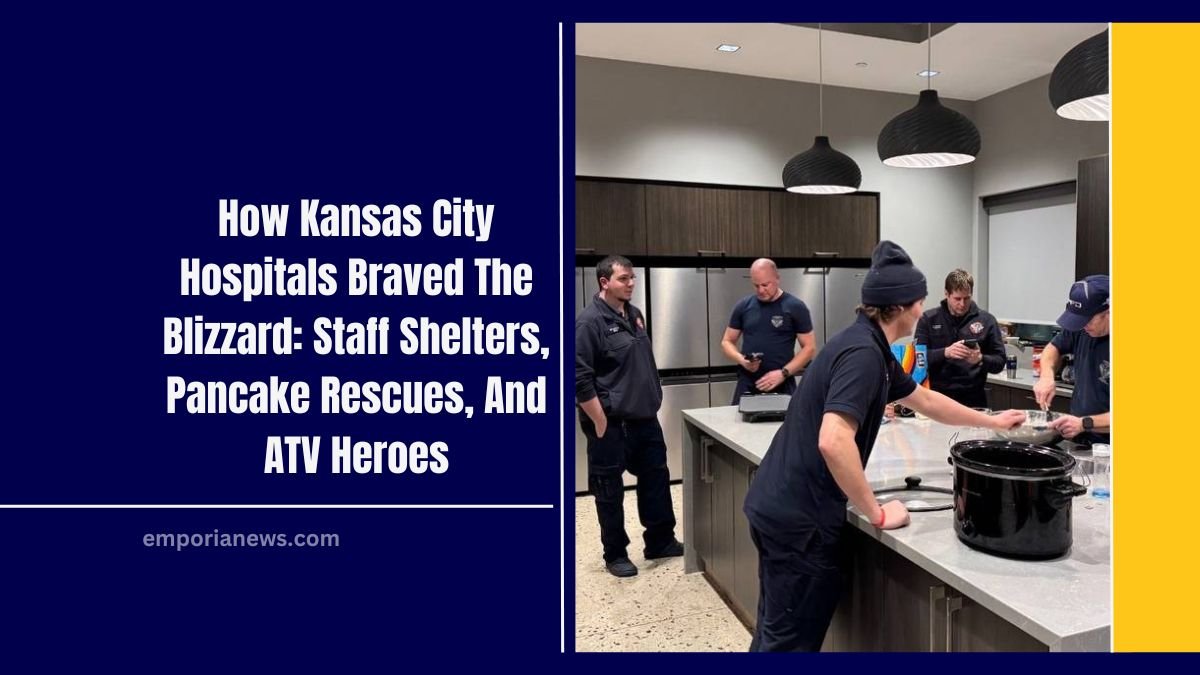When a blizzard shut down much of Kansas City, schools, businesses, and even government offices came to a halt. Yet, the city’s hospitals remained open, thanks to meticulous preparation, creative problem-solving, and community generosity.
From staff staying overnight to pancake breakfasts provided by firefighters, Kansas City’s medical institutions showcased resilience and dedication during extreme weather.
The Blizzard That Tested Kansas City’s Hospitals
In January 2025, a severe winter storm blanketed Kansas City with snow, sub-freezing temperatures, and treacherous road conditions.
While much of the city shut down, hospitals and emergency services couldn’t afford to take a snow day. Here’s how these critical institutions managed to stay operational:
1. Housing for Hospital Staff
Hospitals anticipated staffing shortages due to dangerous road conditions and arranged on-site accommodations for employees.
- University of Kansas Health System: Reserved housing on campus for hundreds of medical and non-medical staff, ensuring rest was available for those covering extended shifts.
- Children’s Mercy Hospital: Hosted 165 staff members overnight, the highest number recorded during a weather emergency.
- Saint Luke’s Hospitals: Provided food, hygiene supplies, and sleeping areas for employees who couldn’t commute.
These efforts ensured critical care continued uninterrupted, even as the storm raged outside.
2. Community Support: Pancakes for Healthcare Workers
Amid the chaos, a heartwarming story unfolded at AdventHealth Shawnee Mission. When firefighters from Station 41 learned that the hospital’s emergency room staff had no food, they raided their own pantry to prepare a pancake breakfast complete with eggs and fruit.
- Reason for the Shortage: A temporary suspension of transportation services during the storm caused staffing gaps in the hospital’s nutrition department.
- Outcome: Firefighters’ generosity provided much-needed nourishment for ER workers who had stayed on duty through the storm.
3. Transportation via ATVs
Getting essential workers to hospitals during the storm required creative solutions.
- Midwest Krawlers’ Snow Squad: An off-road club mobilized all-terrain vehicles (ATVs) to transport healthcare workers and first responders.
- Impact: The group completed over 300 rides across Kansas City, ensuring staff could reach hospitals and emergency sites.
This volunteer effort played a critical role in keeping medical facilities fully staffed during the worst of the weather.
4. Preparation Before the Storm
Kansas City’s hospitals didn’t wait for the storm to arrive—they implemented emergency plans well in advance.
- Food Supplies: Hospitals stocked surplus food, prioritizing patient meals over staff.
- Equipment Maintenance: Snowplows and other equipment were on standby to clear hospital grounds.
- Communication Systems: Staff members were updated regularly, allowing them to plan for extended shifts or arrange alternative transportation.
| Hospital | Measures Taken | Impact |
|---|---|---|
| University of Kansas Health System | Reserved on-site housing for hundreds of staff. | Ensured continuous care during the storm. |
| Children’s Mercy Hospital | Accommodated 165 staff members overnight. | Record number of staff on-site. |
| Saint Luke’s Hospitals | Provided food, hygiene supplies, and sleeping areas. | Enhanced staff morale and availability. |
| AdventHealth Shawnee Mission | Coordinated transportation and prioritized patient care. | Minimized disruptions to patient services. |
The Kansas City blizzard of 2025 highlighted the unwavering commitment of hospitals and emergency services to their communities.
From pancake breakfasts to ATV rides, these efforts showcased the resilience and creativity needed to overcome extreme challenges.
Kansas City’s hospitals not only weathered the storm—they thrived, ensuring that patient care and staff support remained uncompromised.
This extraordinary response underscores the power of preparation, teamwork, and community spirit during crises.
FAQs
How did hospitals ensure sufficient staffing during the storm?
Hospitals provided on-site accommodations for staff, utilized volunteer transportation services like ATVs, and prioritized communication to manage schedules effectively.
What role did the community play in supporting hospital staff?
Local firefighters prepared meals for healthcare workers, and volunteer groups like Midwest Krawlers provided transportation for essential employees.
Were patient services affected during the blizzard?
Despite minor disruptions in staff amenities, patient care remained a top priority and was largely unaffected due to pre-planning and community support.




